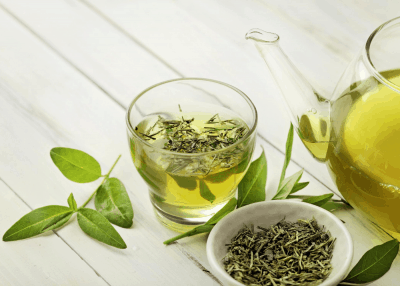
Do You Know Tea Leaves from Tisanes? Antioxidant Capacity Compared
Share

Green tea or not green tea – that is the question!
With the ever-increasing popularity of Green Tea, both as a beverage and in skincare, green tea antioxidants are a must-have ingredient. However, do you know your tea leaves from your tisanes?
Let’s take a closer look at what ‘green’ tea means and how the antioxidant capacity of green teas compare, especially when it comes to red light therapy.
Difference between a tea and a tisane
At first glance, tea and tisane seem like the same thing. However, that is not exactly the case. We’ll explain.
Strictly speaking, anything that's not made from the tea plant (Camellia sinensis) is considered a tisane.
In the analysis below, we'll compare and contrast the antioxidant properties and what they mean for LED light therapy.
|
Feature |
Green Tea |
Green Rooibos (Tisane) |
|
Source Plant |
Camellia sinensis |
Aspalathus linearis (herb) |
|
Caffeine Content |
Yes |
No |
|
Processing Method |
Minimally oxidised to retain phenolic content |
Unfermented; prevents oxidation to preserve flavonoids |
|
Key Antioxidants |
EGCG (Epigallocatechin-3-gallate), flavonoids |
Aspalathin, 187+ phenolic compounds |
|
Antioxidant Potential |
High |
Comparable to green tea (based on MAYSAMA studies) |
|
Bioactivity in Cells |
Scavenges free radicals; stimulates the cell’s defence network |
Same cellular effects as green tea; triggers antioxidant pathways |
|
Relation to Red Light Therapy |
Enhances LED results by neutralising reactive oxygen |
Believed to work similarly; evidence suggests synergy with LED, but no formal claims testing has been conducted |
|
Unique Benefits |
Well-documented synergy with LED therapy |
Caffeine-free, high aspalathin content; patented extract offers boosted antioxidant performance |
Green Tea
Green Tea
Green Tea comes from the plant Camellia sinensis, which is native to China. In fact, black tea and white tea come from the same plant.
For black tea, the leaves are first rolled and then exposed to air to start a process of oxidation that darkens the leaves and gives the tea its characteristic flavour.
Green tea, on the other hand, is processed to prevent oxidation and, as a result, it has a much higher phenolic content and antioxidant potential.
More specifically, green and black tea contain a subgroup of polyphenols called flavonoids. Green tea contains a much higher amount of Epigallocatechin-3-gallate (EGCG), whereas black tea is a rich source of theaflavins.
Green, black and white tea have a high content of caffeine.
Matcha
Matcha
Matcha also comes from the plant Camellia sinensis.
Matcha was discovered by a Buddhist monk and brought to Japan. Matcha is 100% green tea leaves, which have been stone ground into a fine powder. It is made into a beverage from its powdered form, such that the whole tea leaf is consumed.
Matcha is grown and prepared differently from green tea, with one of the main differences being that green tea undergoes more processing, which involves the tea plants being cultivated in the sun.
Comparatively, matcha tea plants are shielded from the sun for around 20-30 days before harvest, which concentrates the chlorophyll and amino acids in the leaves and increases the caffeine content.
Green Rooibos Herbal Tea
Green Rooibos Tea
Rooibos is an herb native to the Western Cape of South Africa, called Aspalathus linearis.
For centuries, the indigenous Khoisan women of South Africa have sipped the distinct red coloured herbal tea and sworn by its soothing and healing properties.
They bruised the wet, freshly cut, needle-like leaves of the native shrub and allowed them to ferment in the hot African sun, turning the herb red. The resultant rooibos tea, better known as ‘redbush, was traditionally used as an herbal medicine for a wide range of ailments.
The fermentation process, however, destroys 90% of the Aspalathin, a unique flavonoid abundant in rooibos and largely responsible for its antioxidant activity.
In recent years, Green Rooibos has become popular, both as a tea beverage and for use in the pharmaceutical industry to treat Type II diabetes.
Green rooibos is harvested from the fresh green, unfermented leaves and has a much higher polyphenolic content because the flavonoids have not been destroyed by oxidation.
Whilst loosely referred to as a ‘green’ tea, because it is made from the fresh leaves and is not oxidised, strictly speaking, green rooibos is a tisane, or herbal tea.
Unlike green tea (and black tea or white tea), rooibos tea does not contain caffeine.
MAYSAMA Green Rooibos Pressed Serum
Green rooibos and red light therapy
In terms of antioxidant potential, green rooibos has perhaps been seen as the poor relation to green tea. That is, until 2019 when MAYSAMA, a British skincare brand, set up a research collaboration with the Nelson Mandela Institute in South Africa to look at the cosmetic potential of rooibos, and their studies have some remarkable findings.
These recent studies show that the antioxidant potential of MAYSAMA’s green rooibos-powered extract is comparable to green tea, and, what’s more, its mode of action within the cellular environment may trigger the same metabolic pathways as green tea.
Other antioxidants tested in the study, including resveratrol and vitamin E, whilst delivering substantial antioxidant activity outside of the cell, did not deliver the same antioxidant protection inside the cell and appeared to work against the cell’s natural antioxidant defences.
Green tea antioxidants and green rooibos tea extracts, on the other hand, were bioactive to a similar degree, scavenging free radicals inside the cell and stimulating the cell’s intrinsic defence network.
Whilst green tea is best known for the catechin EGCG and rooibos is best known for the flavonoid Aspalathin, both green tea and green rooibos tea contain a plethora of polyphenolic compounds that work together and have additive effects for antioxidant protection.
Rooibos, in fact, has more than 187 phenolic compounds that work synergistically to enhance its antioxidant capacity beyond the sum of its parts.
On account of the results of their scientific studies, MAYSAMA launched Green Rooibos Pressed Serum in February 2020. This antioxidant serum is formulated with pharmaceutical-grade, aspalathin-enriched Green Rooibos extract as an Active Pharmaceutical Ingredient.
The patented extraction process concentrates the aspalathin to produce a cosmetic ingredient with far greater potency and antioxidant potential.
You can read more about the benefits of green rooibos on this link.
Which is better for red light therapy: Green tea or green rooibos?
If you’re using red light therapy (RLT) to support skin health or reduce signs of ageing, pairing it with the right antioxidant can make a big difference. Here’s what you need to know:
Does green tea help with red light therapy?
Green tea has long been a favourite in this space, thanks to a 2009 study showing that combining green tea extract with LED therapy accelerated skin rejuvenation results by up to ten times.
The science behind it is solid: red light stimulates the production of reactive oxygen species (ROS), which help trigger repair and regeneration. Green tea’s key antioxidant, EGCG (Epigallocatechin-3-gallate), helps neutralise excess ROS and activates the cell’s natural defence pathways, making the treatment more effective and better tolerated.
But while green tea has the published research, green rooibos may quietly be the more exciting contender, especially for those with sensitive skin.
What about rooibos?
Unlike green tea, which contains caffeine and tannins that can occasionally cause irritation, green rooibos is naturally caffeine-free and incredibly gentle.
What makes green rooibos especially compelling is that it offers this cellular protection without overstimulating or irritating the skin. With all those polyphenolic compounds working in synergy, green rooibos delivers a broader spectrum of antioxidant action. And while it doesn’t yet have formal studies proving its synergy with red light therapy, the emerging science is promising.
Tisane, green tea, and red light therapy: Final words
Now that you’ve read all this, let’s summarise the findings:
‘Green’ teas are harvested from the fresh leaves, which have not been oxidised. As a result, green tea antioxidants, both green tea and green rooibos tea, have a higher phenolic content, which results in an increased antioxidant potential.
Green tea and tisane, unlike other antioxidants, work in harmony with the cell and, aside from their own free radical scavenging capability, enhance the cell's natural antioxidant network and increase the cell's ability to resist oxidative stress.
Whether green tea or green rooibos tea, ‘green’ tea polyphenols have indeed got you covered for antioxidant protection!
For more information on MAYSAMA Green Rooibos Pressed Serum, visit their website or follow maysama_beauty on Instagram.




